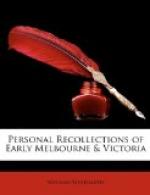A vision of earliest Melbourne rises before me. Allotment speculators were bound, within moderate time, to construct a “dwelling” on their purchase, and in some cases these were made with honest intention, as in the two adjacent half-acres of Mr. James Smith and Mr. Skene Craig in west Collins-street. But in most cases these coerced structures were only shams, which disappeared right early. The only “buildings” on a good many sections, that are now central and almost priceless, were post-and-rail fences, somewhat dilapidated at places by our license of jumping over them for a short diagonal to adjacent streets.
Let me try to recall the Melbourne of 1840, as it looked in that year, the year of my arrival. In the first place I must protest against the meagre view given some years ago in the “Illustrated London News”, from a sketch by Mossman, an early colonist of my acquaintance, and copied into the lively and pleasant volume of my esteemed friend, Miss Isabella Bird (now Mrs. Bishop). It may be true as far as it goes, but it is only the Western Market square, which had hardly one-thirtieth part of that year’s Melbourne. At the close of 1840 there were between three and four thousand of population, although perhaps one-fourth of these, who had been recently shot out of emigrant ships, were merely waiting for employment or settlement. The whole District had about nine thousand. Curiously enough, Melbourne (including suburbs) has always had about one-third of the total colonial population, while Sydney and Adelaide respectively have been much the same. But this naturally comes of a vast interior behind, which has practically only the one outlet. In New Zealand, on the other hand, the long strip of land, with the sea near to




